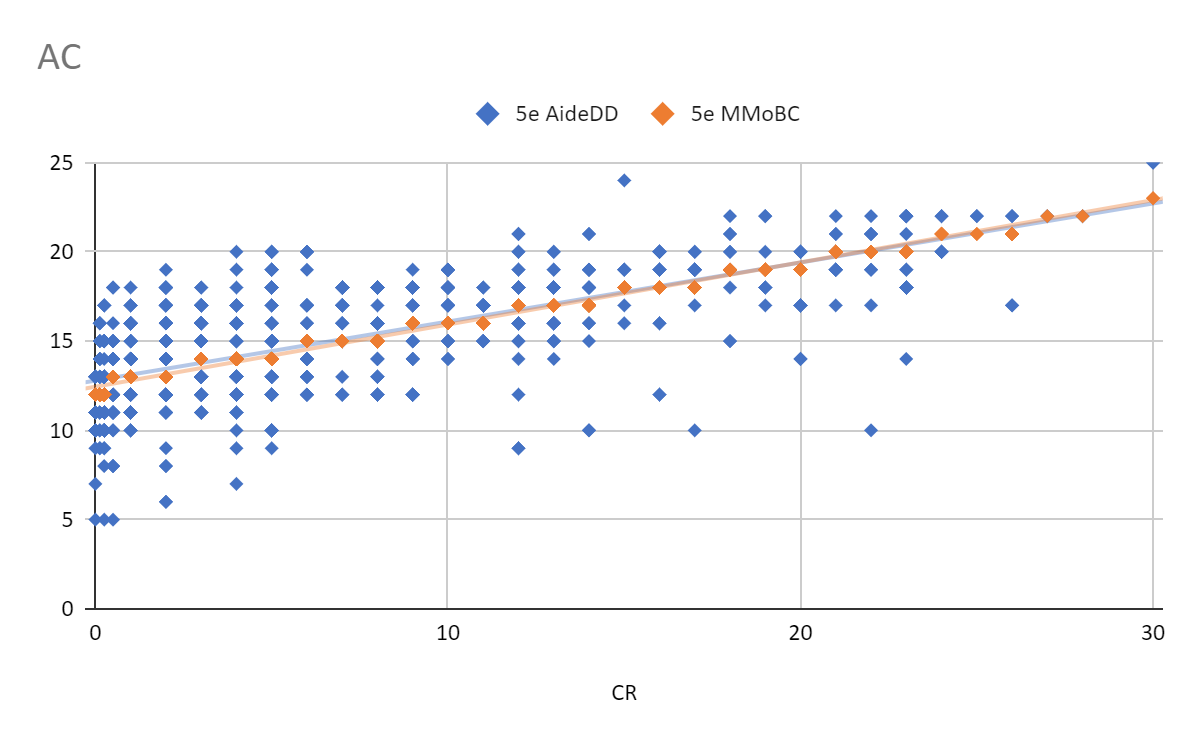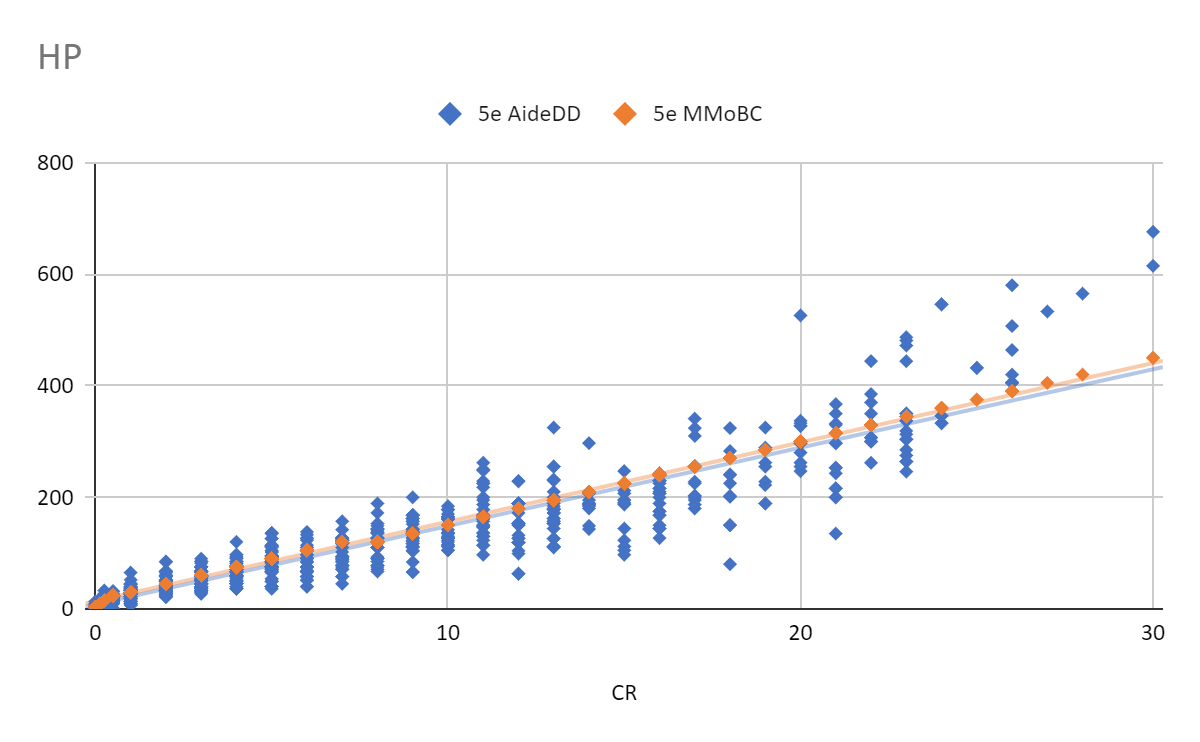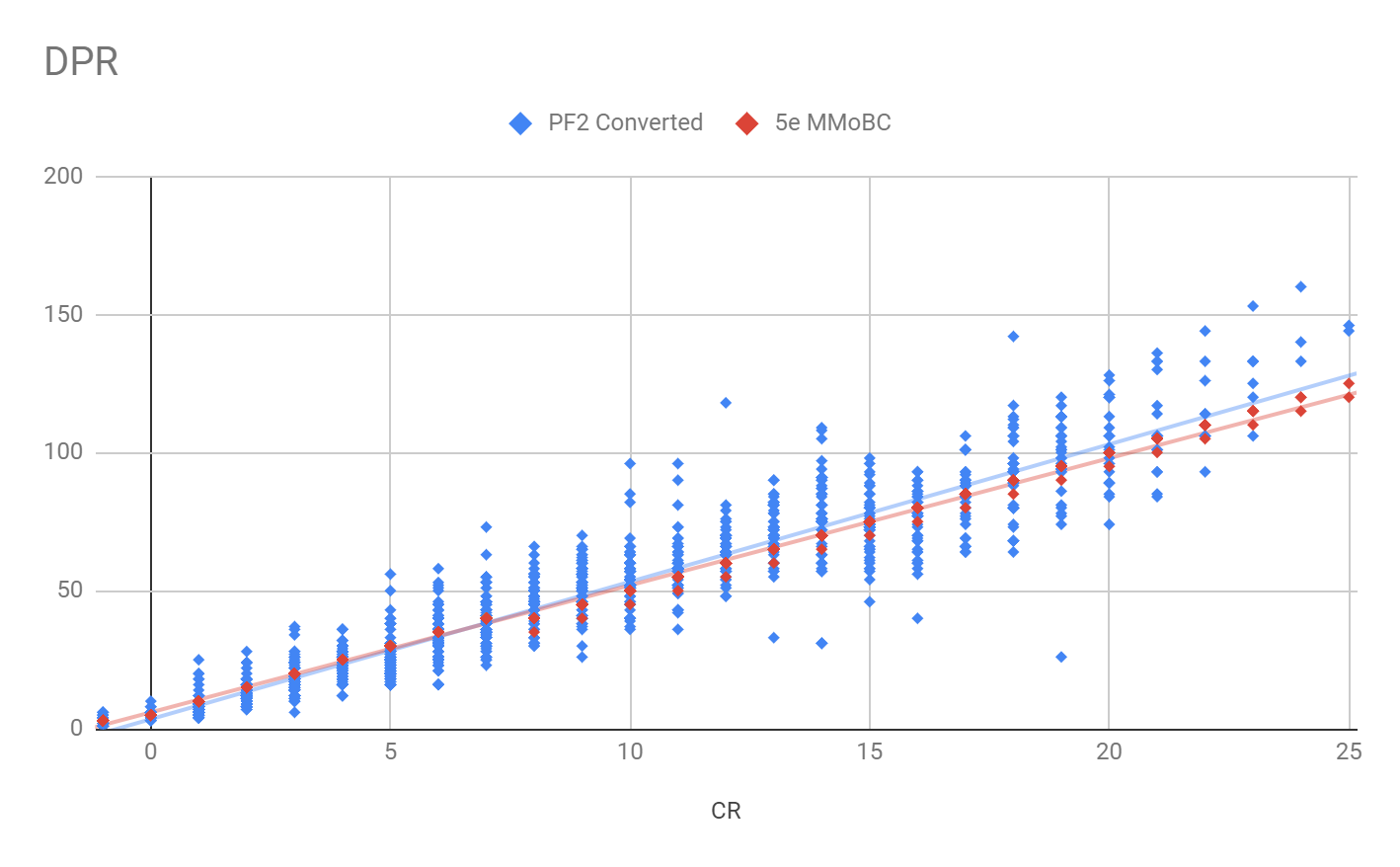Carcharoth
Explorer
In response to the OGL upheaval and uncertainty of last month, I recently formalized and shared a newer version of Converting 3.5e and Pathfinder 1 Monsters to 5e that was updated to use expected values from Blog of Holding’s 5e Monster Manual on a Business Card as its foundation. As a natural extension of that work, I decided to do the same for Pathfinder 2.
May those of you who enjoy the quality of PF2 adventure paths, modules, and scenarios but prefer the 5e system find the following useful.
It is important to keep in mind that converted monsters retain their original CR. For example, a PF2 hill giant converted to 5e remains CR 7 rather than decreasing to CR 5 as listed in the 5e MM.
Note: PF2 now uses the term Level rather than CR for monsters. For purposes of familiarity, this guide uses CR.
Note: Round down fractional results
As a result of this guide using the MMoBC as its foundation, an overwhelming number of converted PF2 stats end up being just as viable as any of those contained within official 5e resources released up to and including 2022.
The dataset from which the equations were derived contains 2288 official PF2 monsters from a variety of sources including Bestiaries 1 to 3, assorted modules, adventure paths, and so on.
Results: 99.34% of entries (2273 out of 2288) fall within +/-3 of expected values.
Outstanding considering that 90.26% of 1027 monsters from official 5e resources match the same criteria. See 5e Monster Data Sources below for further details.
Distribution of PF2 Converted ACs and MMoBC equations

Distribution of Official 5e ACs and MMoBC equations

Results: 97.12% of entries (2222 of 2288) fall between +/- 50% of the expected value.
Excellent considering that 90.46% of 1027 monsters from official 5e resources match the same criteria. See 5e Monster Data Sources below for further details.
Distribution of PF2 Converted HP and MMoBC equations

Distribution of Official 5e HP and MMoBC equations

Results: 96.98% of entries (2219 of 2288) fall between +/- 50% of the expected value.
Excellent considering that 82.53% of the 395 monsters in the 5e MM that do attack damage match the same criteria. See 5e Monster Data Sources below for further details.
Distribution of PF2 Converted DPR and MMoBC equations

Distribution of 5e MM DPR and MMoBC equations

For more information on dividing the DPR total (budget) into attacks, see 5e Monster Manual on a Business Card on Blog of Holding (BoH)
Results: The precision of this equation will become clear after calculating the Attack Bonus below.
The PB is an integral part of 5e design and is used to calculate the following primary stats: Attack Bonuses, Saving Throws, Difficulty Checks, and number of Skills.
Results: 96.11% of entries (2199 out of 2288) fall within +/- 2 of expected values while 99.74% (2282 of 2288) are within +/- 3.
Excellent considering that, of the 797 official monsters with available stats, 91.59% fall within +/- 2 while 96.61% fall within +/- 3. See 5e Monster Data Sources below for further details.
At this point, it becomes clear that the Ability Modifier is practically dead on and, as a result, the remainder of stats also fall in line with similar precision.
Distribution of PF2 Converted ABs and MMoBC equation

Distribution of Official 5e ABs and MMoBC equation

Note: In both systems, some values beyond the range of tolerance are accounted for by monsters that rely on Spell DCs rather than ABs.
It is important to note that PF2 CR -1 stats overwhelmingly match 5e CR 1/8 values.
To provide 5e CR 0 equivalent challenges, you could lower the converted CR -1 monster’s HP and DPR to somewhere between 1 to 5 and 1 to 3 respectively. Because the majority of converted PF2 CR -1 ACs and ABs fall within expected 5e values, the result will be a reasonably balanced CR 0 version.
Like the previous guide, compressing the entire range of ACs provides not only greater precision but also greater variety at the top (less of a direct relationship between CR and AC).
As a result, the recomputed PF1e AC range of 20 to 50 becomes 20 to 30, thereby matching 5e.
Although the official Wizards conversion doc suggests capping AC at 22, the Pathfinder multiverse contains a handful of monsters that are intended to approach if not rival a tarrasque. Consequently, a total of 32 out of 2288 re-computed ACs range from 23 to 25.
Note: There are a few exceptions. Although the top five monsters have a final AM of +11, only two of them (Tarrasque and Treerazer) end up with an Attack Bonus of 19, which puts them +1 over the MMoBC’s expected tolerance of +/-2 for an AB of 16.
Example:
For those who are interested, one such comprehensive doc is the Content Conversion Guide by Infinium Games (no affiliation, just a satisfied customer).
I hope that some of you will take advantage of the ease with which you can quickly convert PF2 monster stats to 5e. Whether you decide to give some of the numerous, high quality PF2 adventures a spin or start incorporating any number of the thousands of freely available monsters and NPCs into your homebrew campaign, there’s more than enough variation and material to spice things up for years.
With respect to variation, those with seasoned players may even choose to shake up complacency by introducing stronger variations of common monsters. For example, since CRs remain unchanged, a converted PF2 Rust Monster of CR 3 can be a nice surprise for a group that is used to the standard CR 1/2 version.
If you find any mistakes or have further insights, please feel free to leave a message in the comments below.
May those of you who enjoy the quality of PF2 adventure paths, modules, and scenarios but prefer the 5e system find the following useful.
Summary
The table below contains a set of equations that you can use to convert the primary stats of Pathfinder 2 monsters into versions that are overall just as statistically sound as those found in official 5e resources. With a cheat sheet and a little practice you should be able to do the calculations in your head in no time.It is important to keep in mind that converted monsters retain their original CR. For example, a PF2 hill giant converted to 5e remains CR 7 rather than decreasing to CR 5 as listed in the 5e MM.
Note: PF2 now uses the term Level rather than CR for monsters. For purposes of familiarity, this guide uses CR.
| Armor Class: | (AC - 10)/ 3, + 11 CR < 21 and new AC > 20, then 20 Tolerance: +/- 3 |
| Hit Points: | CR -1 to 0, then HP CR 1 to 4, then HP + 20% CR 5 to 9, then HP CR 10 to 14, then HP - 10% CR 15+, then HP - 20% Tolerance: +/- 50% |
| Damage per Round: | HP/ 3 Tolerance: +/- 50% |
| Ability Modifiers: | AM - 1 Tolerance: +/- 2 |
| Proficiency Bonus: | (CR - 1)/4, + 2 |
| Attack Bonus: | Appropriate AM + PB Tolerance: +/- 2 |
| Saving Throws: | Appropriate AM (+ PB if Good Save) |
| Save DC: | Appropriate AM + PB + 8 |
| Skills: | Appropriate AM (+ PB if proficient) |
Details
Like its companion 3.5/ PF1 guide, the target values for conversion are based on the 5e Monster Manual on a Business Card (MMoBC) by Blog of Holding rather than those of the Monster Statistics by Challenge Rating table in the 5e DMG (page 274). For those of you who are unaware, the MMoBC is a literal game changer in that it not only provides an easy-to-use cheatsheet for monster stat creation but also uses data directly from the 5e MM itself to correct the 5e table’s flaws.As a result of this guide using the MMoBC as its foundation, an overwhelming number of converted PF2 stats end up being just as viable as any of those contained within official 5e resources released up to and including 2022.
The dataset from which the equations were derived contains 2288 official PF2 monsters from a variety of sources including Bestiaries 1 to 3, assorted modules, adventure paths, and so on.
Armor Class (AC)
| Armor Class: | (AC - 10)/ 3, + 11 CR < 21 and new AC > 20, then 20 Tolerance: +/- 3 |
Results: 99.34% of entries (2273 out of 2288) fall within +/-3 of expected values.
Outstanding considering that 90.26% of 1027 monsters from official 5e resources match the same criteria. See 5e Monster Data Sources below for further details.
Distribution of PF2 Converted ACs and MMoBC equations
Distribution of Official 5e ACs and MMoBC equations
Hit Points (HP)
| Hit Points: | CR -1 to 0, then HP CR 1 to 4, then HP + 20% CR 5 to 9, then HP CR 10 to 14, then HP - 10% CR 15+, then HP - 20% Tolerance: +/- 50% |
Results: 97.12% of entries (2222 of 2288) fall between +/- 50% of the expected value.
Excellent considering that 90.46% of 1027 monsters from official 5e resources match the same criteria. See 5e Monster Data Sources below for further details.
Distribution of PF2 Converted HP and MMoBC equations
Distribution of Official 5e HP and MMoBC equations
Damage Per Round
| DPR: | HP/ 3 rounded down. Tolerance: +/- 50% |
Results: 96.98% of entries (2219 of 2288) fall between +/- 50% of the expected value.
Excellent considering that 82.53% of the 395 monsters in the 5e MM that do attack damage match the same criteria. See 5e Monster Data Sources below for further details.
Distribution of PF2 Converted DPR and MMoBC equations
Distribution of 5e MM DPR and MMoBC equations
For more information on dividing the DPR total (budget) into attacks, see 5e Monster Manual on a Business Card on Blog of Holding (BoH)
Ability Modifiers (AM)
| Ability Modifiers: Ability Score (AS) | AM - 1 Tolerance: +/- 2 |
Results: The precision of this equation will become clear after calculating the Attack Bonus below.
Proficiency Bonus (PB)
| Proficiency Bonus: | (CR - 1)/4 rounded down + 2 |
The PB is an integral part of 5e design and is used to calculate the following primary stats: Attack Bonuses, Saving Throws, Difficulty Checks, and number of Skills.
Attach Bonus (AB)
| Attack Bonus: | Appropriate AM + PB Tolerance: +/- 2 |
Results: 96.11% of entries (2199 out of 2288) fall within +/- 2 of expected values while 99.74% (2282 of 2288) are within +/- 3.
Excellent considering that, of the 797 official monsters with available stats, 91.59% fall within +/- 2 while 96.61% fall within +/- 3. See 5e Monster Data Sources below for further details.
At this point, it becomes clear that the Ability Modifier is practically dead on and, as a result, the remainder of stats also fall in line with similar precision.
Distribution of PF2 Converted ABs and MMoBC equation
Distribution of Official 5e ABs and MMoBC equation
Note: In both systems, some values beyond the range of tolerance are accounted for by monsters that rely on Spell DCs rather than ABs.
Saving Throws, Difficulty Checks, and Skills
Since the remaining stats rely just as much on Ability Modifiers as the Attack Bonus does, they too will match expected values with similar precision.Saving Throws
| Saving Throws: | Appropriate Ability Modifier (+ Proficiency Bonus if Good Save). |
Save Difficulty Check (DC)
| Save DC: | Appropriate Ability Modifier + Proficiency Bonus + 8. |
Skills (number of)
| Skills: | Appropriate Ability Modifier (+ Proficiency Bonus if proficient). |
Final 5 CR Ratings
| PF2 | 5e |
| -1 | 1/8 |
| 0 | 1/4 to 1/2 |
| 1+ | 1+ |
It is important to note that PF2 CR -1 stats overwhelmingly match 5e CR 1/8 values.
To provide 5e CR 0 equivalent challenges, you could lower the converted CR -1 monster’s HP and DPR to somewhere between 1 to 5 and 1 to 3 respectively. Because the majority of converted PF2 CR -1 ACs and ABs fall within expected 5e values, the result will be a reasonably balanced CR 0 version.
Notes on Compression and Maximums
Armor Class
About 52% of PF2 monsters have an AC over 20 while about 22% have an AC over 30.Like the previous guide, compressing the entire range of ACs provides not only greater precision but also greater variety at the top (less of a direct relationship between CR and AC).
As a result, the recomputed PF1e AC range of 20 to 50 becomes 20 to 30, thereby matching 5e.
Although the official Wizards conversion doc suggests capping AC at 22, the Pathfinder multiverse contains a handful of monsters that are intended to approach if not rival a tarrasque. Consequently, a total of 32 out of 2288 re-computed ACs range from 23 to 25.
Ability Scores and Modifiers
PF2 no longer uses Ability Scores so only Ability Modifiers are listed in a PF2 stat block. Additionally, PF2 AMs have been lowered from their previously high 3.X/ PF1 values to an average of +1 over expected 5e values (accounted for in the AM equation).Note: There are a few exceptions. Although the top five monsters have a final AM of +11, only two of them (Tarrasque and Treerazer) end up with an Attack Bonus of 19, which puts them +1 over the MMoBC’s expected tolerance of +/-2 for an AB of 16.
Additional Ability Modifier and Ability Score Calculations
Should the need or desire arise to calculate a 5e Ability Score from a PF2 Ability Modifier, the following equation will be useful.PF2 Ability Modifier to 5e Ability Score
| Ability Score: | (AM - 1) * 2, + 10 |
Example:
| AM = +11 | 5e AS = 30
|
5e Monster Data Sources
In an effort to expand sample sizes from MMoBC’s original analysis, 3 separate datasets were used (unfortunately, the largest dataset did not include all 4 necessary stats).AC and HP dataset
1027 monsters from AideDD’s Monsters 5e Page (official 5e resources released through 2022) were used to compare and contrast the distribution of AC and HP to the MMoBC equations.Attack Bonus dataset
797 monsters from The Great D&D 5e Monster Spreadsheet (official resources released through 2017) were used to compare and contrast the distribution of ABs to the MMoBC equation.DPR dataset
395 monsters from the MMoBC spreadsheet (5e MM only) that dealt damage were used to compare and contrast the distribution of DPR to the MMoBC equation.What about Skills, Vulnerabilities, Conditions, etc.?
Several people have already done an excellent job of mapping various skills, vulnerabilities, conditions, and other attributes to 5e, so those efforts are not repeated here.For those who are interested, one such comprehensive doc is the Content Conversion Guide by Infinium Games (no affiliation, just a satisfied customer).
Conclusion
As mentioned previously, as a result of this guide using the MMoBC as its foundation, an overwhelming number of converted PF2 stats end up being just as viable as any of those contained within official 5e resources released up to and including 2022.I hope that some of you will take advantage of the ease with which you can quickly convert PF2 monster stats to 5e. Whether you decide to give some of the numerous, high quality PF2 adventures a spin or start incorporating any number of the thousands of freely available monsters and NPCs into your homebrew campaign, there’s more than enough variation and material to spice things up for years.
With respect to variation, those with seasoned players may even choose to shake up complacency by introducing stronger variations of common monsters. For example, since CRs remain unchanged, a converted PF2 Rust Monster of CR 3 can be a nice surprise for a group that is used to the standard CR 1/2 version.
If you find any mistakes or have further insights, please feel free to leave a message in the comments below.
PS
Anyone who is serious about well balanced monster creation should read Level Up’s Designing Monsters (same author of the MMoBC).
Last edited:
